battery YAMAHA MT-25 2016 Owners Manual
[x] Cancel search | Manufacturer: YAMAHA, Model Year: 2016, Model line: MT-25, Model: YAMAHA MT-25 2016Pages: 96, PDF Size: 5.16 MB
Page 6 of 96
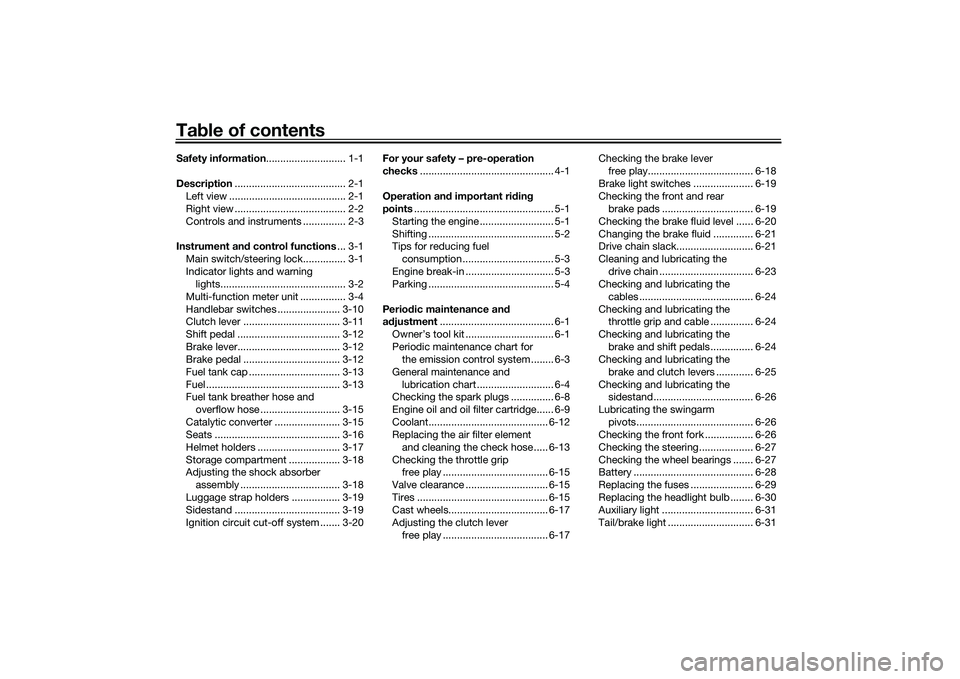
Table of contentsSafety information............................ 1-1
Description....................................... 2-1
Left view ......................................... 2-1
Right view ....................................... 2-2
Controls and instruments ............... 2-3
Instrument and control functions... 3-1
Main switch/steering lock............... 3-1
Indicator lights and warning
lights............................................ 3-2
Multi-function meter unit ................ 3-4
Handlebar switches ...................... 3-10
Clutch lever .................................. 3-11
Shift pedal .................................... 3-12
Brake lever.................................... 3-12
Brake pedal .................................. 3-12
Fuel tank cap ................................ 3-13
Fuel ............................................... 3-13
Fuel tank breather hose and
overflow hose ............................ 3-15
Catalytic converter ....................... 3-15
Seats ............................................ 3-16
Helmet holders ............................. 3-17
Storage compartment .................. 3-18
Adjusting the shock absorber
assembly ................................... 3-18
Luggage strap holders ................. 3-19
Sidestand ..................................... 3-19
Ignition circuit cut-off system ....... 3-20For your safety – pre-operation
checks............................................... 4-1
Operation and important riding
points................................................. 5-1
Starting the engine .......................... 5-1
Shifting ............................................ 5-2
Tips for reducing fuel
consumption ................................ 5-3
Engine break-in ............................... 5-3
Parking ............................................ 5-4
Periodic maintenance and
adjustment........................................ 6-1
Owner’s tool kit ............................... 6-1
Periodic maintenance chart for
the emission control system ........ 6-3
General maintenance and
lubrication chart ........................... 6-4
Checking the spark plugs ............... 6-8
Engine oil and oil filter cartridge...... 6-9
Coolant.......................................... 6-12
Replacing the air filter element
and cleaning the check hose..... 6-13
Checking the throttle grip
free play ..................................... 6-15
Valve clearance ............................. 6-15
Tires .............................................. 6-15
Cast wheels................................... 6-17
Adjusting the clutch lever
free play ..................................... 6-17Checking the brake lever
free play..................................... 6-18
Brake light switches ..................... 6-19
Checking the front and rear
brake pads ................................ 6-19
Checking the brake fluid level ...... 6-20
Changing the brake fluid .............. 6-21
Drive chain slack........................... 6-21
Cleaning and lubricating the
drive chain ................................. 6-23
Checking and lubricating the
cables ........................................ 6-24
Checking and lubricating the
throttle grip and cable ............... 6-24
Checking and lubricating the
brake and shift pedals............... 6-24
Checking and lubricating the
brake and clutch levers ............. 6-25
Checking and lubricating the
sidestand................................... 6-26
Lubricating the swingarm
pivots......................................... 6-26
Checking the front fork ................. 6-26
Checking the steering................... 6-27
Checking the wheel bearings ....... 6-27
Battery .......................................... 6-28
Replacing the fuses ...................... 6-29
Replacing the headlight bulb ........ 6-30
Auxiliary light ................................ 6-31
Tail/brake light .............................. 6-31UB04E0E0.book Page 1 Wednesday, September 2, 2015 3:51 PM
Page 14 of 96
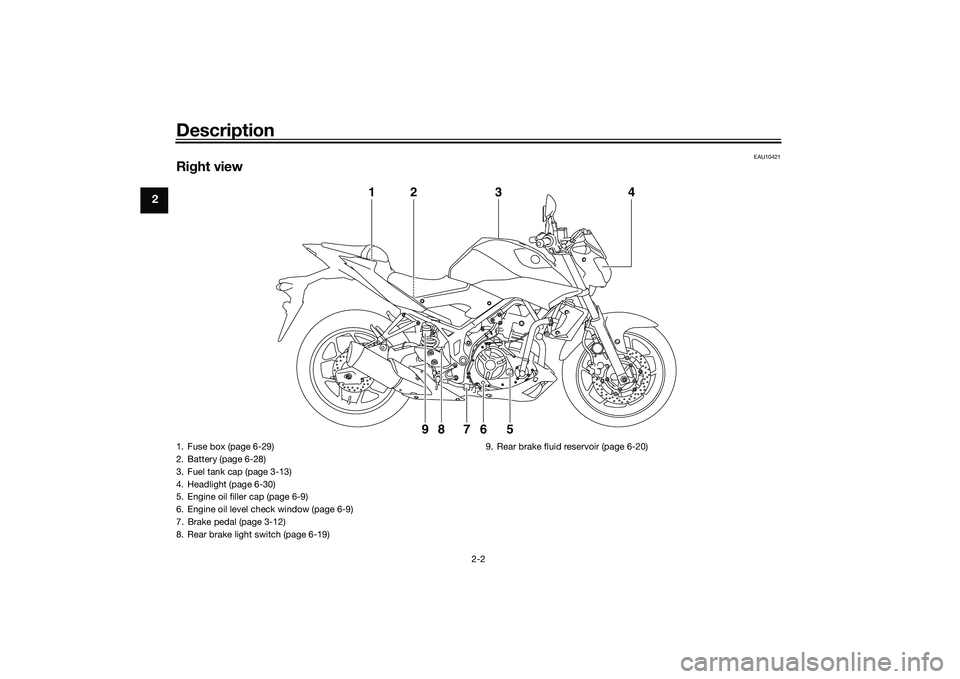
Description
2-2
2
EAU10421
Right view
1
98 76 5 23
4
1. Fuse box (page 6-29)
2. Battery (page 6-28)
3. Fuel tank cap (page 3-13)
4. Headlight (page 6-30)
5. Engine oil filler cap (page 6-9)
6. Engine oil level check window (page 6-9)
7. Brake pedal (page 3-12)
8. Rear brake light switch (page 6-19)9. Rear brake fluid reservoir (page 6-20)UB04E0E0.book Page 2 Wednesday, September 2, 2015 3:51 PM
Page 41 of 96
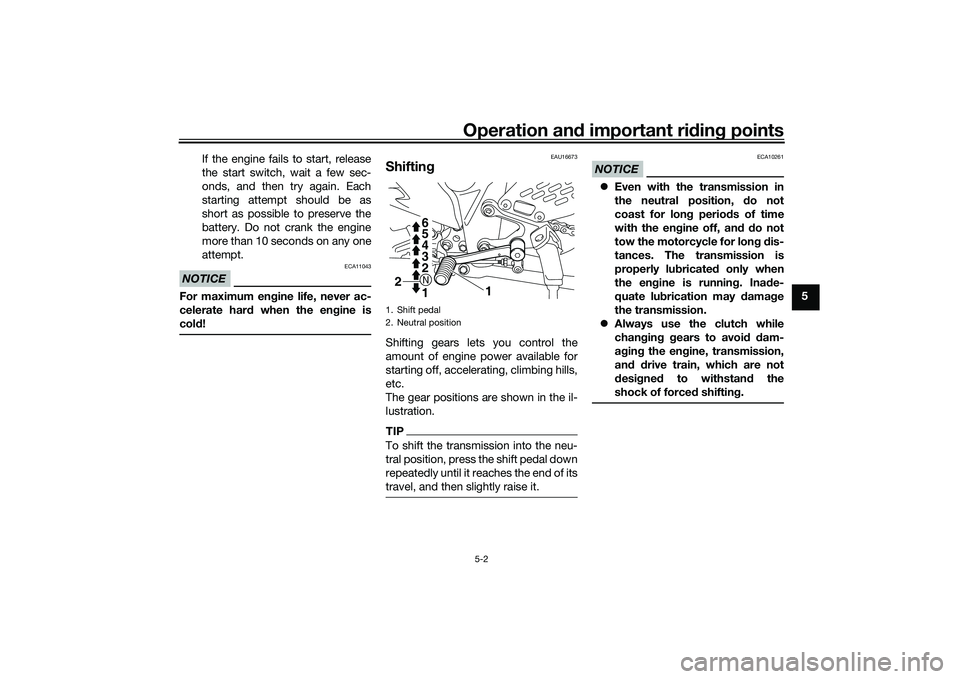
Operation and important riding points
5-2
5 If the engine fails to start, release
the start switch, wait a few sec-
onds, and then try again. Each
starting attempt should be as
short as possible to preserve the
battery. Do not crank the engine
more than 10 seconds on any one
attempt.
NOTICE
ECA11043
For maximum engine life, never ac-
celerate hard when the engine is
cold!
EAU16673
ShiftingShifting gears lets you control the
amount of engine power available for
starting off, accelerating, climbing hills,
etc.
The gear positions are shown in the il-
lustration.TIPTo shift the transmission into the neu-
tral position, press the shift pedal down
repeatedly until it reaches the end of its
travel, and then slightly raise it.
NOTICE
ECA10261
Even with the transmission in
the neutral position, do not
coast for long periods of time
with the engine off, and do not
tow the motorcycle for long dis-
tances. The transmission is
properly lubricated only when
the engine is running. Inade-
quate lubrication may damage
the transmission.
Always use the clutch while
changing gears to avoid dam-
aging the engine, transmission,
and drive train, which are not
designed to withstand the
shock of forced shifting.
1. Shift pedal
2. Neutral position
1
1 2
23 4 5 6N
UB04E0E0.book Page 2 Wednesday, September 2, 2015 3:51 PM
Page 71 of 96
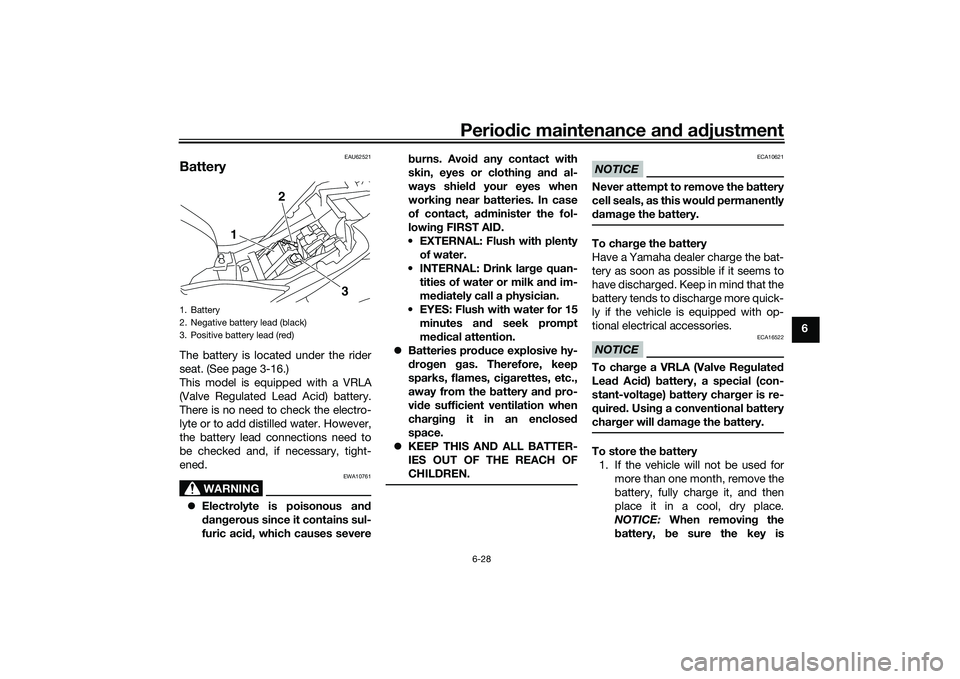
Periodic maintenance and adjustment
6-28
6
EAU62521
BatteryThe battery is located under the rider
seat. (See page 3-16.)
This model is equipped with a VRLA
(Valve Regulated Lead Acid) battery.
There is no need to check the electro-
lyte or to add distilled water. However,
the battery lead connections need to
be checked and, if necessary, tight-
ened.
WARNING
EWA10761
Electrolyte is poisonous and
dangerous since it contains sul-
furic acid, which causes severeburns. Avoid any contact with
skin, eyes or clothing and al-
ways shield your eyes when
working near batteries. In case
of contact, administer the fol-
lowing FIRST AID.
EXTERNAL: Flush with plenty
of water.
INTERNAL: Drink large quan-
tities of water or milk and im-
mediately call a physician.
EYES: Flush with water for 15
minutes and seek prompt
medical attention.
Batteries produce explosive hy-
drogen gas. Therefore, keep
sparks, flames, cigarettes, etc.,
away from the battery and pro-
vide sufficient ventilation when
charging it in an enclosed
space.
KEEP THIS AND ALL BATTER-
IES OUT OF THE REACH OF
CHILDREN.
NOTICE
ECA10621
Never attempt to remove the battery
cell seals, as this would permanently
damage the battery.To charge the battery
Have a Yamaha dealer charge the bat-
tery as soon as possible if it seems to
have discharged. Keep in mind that the
battery tends to discharge more quick-
ly if the vehicle is equipped with op-
tional electrical accessories.NOTICE
ECA16522
To charge a VRLA (Valve Regulated
Lead Acid) battery, a special (con-
stant-voltage) battery charger is re-
quired. Using a conventional battery
charger will damage the battery.To store the battery
1. If the vehicle will not be used for
more than one month, remove the
battery, fully charge it, and then
place it in a cool, dry place.
NOTICE: When removing the
battery, be sure the key is
1. Battery
2. Negative battery lead (black)
3. Positive battery lead (red)
1
2
3
UB04E0E0.book Page 28 Wednesday, September 2, 2015 3:51 PM
Page 72 of 96
![YAMAHA MT-25 2016 Owners Manual Periodic maintenance and adjustment
6-29
6turned to “ ”, then disconnect
the negative lead before discon-
necting the positive lead.
[ECA17712]
2. If the battery will be stored for
more than two YAMAHA MT-25 2016 Owners Manual Periodic maintenance and adjustment
6-29
6turned to “ ”, then disconnect
the negative lead before discon-
necting the positive lead.
[ECA17712]
2. If the battery will be stored for
more than two](/img/51/50981/w960_50981-71.png)
Periodic maintenance and adjustment
6-29
6turned to “ ”, then disconnect
the negative lead before discon-
necting the positive lead.
[ECA17712]
2. If the battery will be stored for
more than two months, check it at
least once a month and fully
charge it if necessary.
3. Fully charge the battery before in-
stallation. NOTICE: When install-
ing the battery, be sure the key
is turned to “ ”, then connect
the positive lead before con-
necting the negative lead.
[ECA17722]
4. After installation, make sure that
the battery leads are properly con-
nected to the battery terminals.NOTICE
ECA16531
Always keep the battery charged.
Storing a discharged battery can
cause permanent battery damage.
EAU62773
Replacing the fusesThe main fuse is located under the
passenger seat. The fuse box, which
contains the fuses for the individual cir-
cuits, is located behind the center pan-
el. (See page 3-16.)
To access the main fuse, proceed as
follows.
1. Remove the passenger seat. (See
page 3-16.)
2. Remove the tray by removing the
quick fasteners.
3. Pull back the starter relay cover.4. Disconnect the starter relay cou-
pler by pressing from both sides.
5. Connect the starter relay coupler,
and then slide the cover to its orig-
inal position.
6. Place the tray in its original posi-
tion, and then install the quick fas-
teners.
7. Install the passenger seat.
TIPTo access the fuse box, remove the
center cover. (See page 3-16.)
1. Quick fastener
2. Tray
21
1. Starter relay cover
2. Starter relay coupler
3. Main fuse
4. Spare main fuse
1
2
34
UB04E0E0.book Page 29 Wednesday, September 2, 2015 3:51 PM
Page 81 of 96

Periodic maintenance and adjustment
6-38
6
EAU42505
Troubleshooting chartsStarting problems or poor engine performance
Check the fuel level in
the fuel tank.1. Fuel
There is enough fuel.
There is no fuel.
Check the battery.
Supply fuel.
The engine does not start.
Check the battery.
Remove the spark plugs
and check the electrodes.3. Ignition
Wipe off with a dry cloth and correct the
spark plug gaps, or replace the spark plugs.
Have a Yamaha dealer check the vehicle.
Operate the electric starter.4. Compression
There is compression.
There is no compression.
The engine does not start.
Have a Yamaha dealer check the vehicle.Have a Yamaha dealer check the vehicle.
The engine does not start.
Check the compression.
Operate the electric starter.2. Battery
The engine turns over
quickly.
The engine turns over
slowly.
The engine does not start.
Check the ignition.
The battery is good.Check the battery lead connections,
and have a Yamaha dealer charge
the battery if necessary.
DryWet
Operate the electric starter.
UB04E0E0.book Page 38 Wednesday, September 2, 2015 3:51 PM
Page 86 of 96
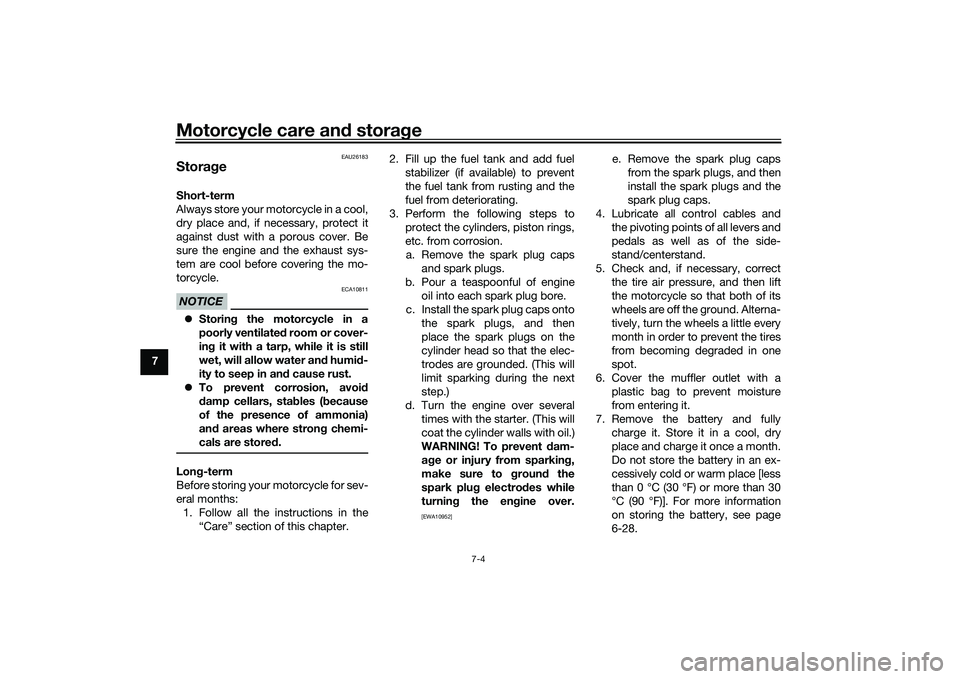
Motorcycle care and storage
7-4
7
EAU26183
StorageShort-term
Always store your motorcycle in a cool,
dry place and, if necessary, protect it
against dust with a porous cover. Be
sure the engine and the exhaust sys-
tem are cool before covering the mo-
torcycle.NOTICE
ECA10811
Storing the motorcycle in a
poorly ventilated room or cover-
ing it with a tarp, while it is still
wet, will allow water and humid-
ity to seep in and cause rust.
To prevent corrosion, avoid
damp cellars, stables (because
of the presence of ammonia)
and areas where strong chemi-
cals are stored.Long-term
Before storing your motorcycle for sev-
eral months:
1. Follow all the instructions in the
“Care” section of this chapter.2. Fill up the fuel tank and add fuel
stabilizer (if available) to prevent
the fuel tank from rusting and the
fuel from deteriorating.
3. Perform the following steps to
protect the cylinders, piston rings,
etc. from corrosion.
a. Remove the spark plug caps
and spark plugs.
b. Pour a teaspoonful of engine
oil into each spark plug bore.
c. Install the spark plug caps onto
the spark plugs, and then
place the spark plugs on the
cylinder head so that the elec-
trodes are grounded. (This will
limit sparking during the next
step.)
d. Turn the engine over several
times with the starter. (This will
coat the cylinder walls with oil.)
WARNING! To prevent dam-
age or injury from sparking,
make sure to ground the
spark plug electrodes while
turning the engine over.
[EWA10952]
e. Remove the spark plug caps
from the spark plugs, and then
install the spark plugs and the
spark plug caps.
4. Lubricate all control cables and
the pivoting points of all levers and
pedals as well as of the side-
stand/centerstand.
5. Check and, if necessary, correct
the tire air pressure, and then lift
the motorcycle so that both of its
wheels are off the ground. Alterna-
tively, turn the wheels a little every
month in order to prevent the tires
from becoming degraded in one
spot.
6. Cover the muffler outlet with a
plastic bag to prevent moisture
from entering it.
7. Remove the battery and fully
charge it. Store it in a cool, dry
place and charge it once a month.
Do not store the battery in an ex-
cessively cold or warm place [less
than 0 °C (30 °F) or more than 30
°C (90 °F)]. For more information
on storing the battery, see page
6-28.
UB04E0E0.book Page 4 Wednesday, September 2, 2015 3:51 PM
Page 89 of 96

Specifications
8-2
8
6th:
0.920 (23/25)
Chassis:Frame type:
Diamond
Caster angle:
25.0 °
Trail:
95 mm (3.7 in)Front tire:Type:
Tubeless
Size:
110/70-17M/C (54S)
Manufacturer/model:
IRC/RX-01FRear tire:Type:
Tubeless
Size:
140/70-17M/C (66S)
Manufacturer/model:
IRC/RX-01RLoading:Maximum load:
160 kg (353 lb)
(Total weight of rider, passenger, cargo
and accessories)Tire air pressure (measured on cold
tires):1 person:
Front:
200 kPa (2.00 kgf/cm2, 29 psi)Rear:
225 kPa (2.25 kgf/cm2, 33 psi)
2 persons:
Front:
200 kPa (2.00 kgf/cm2, 29 psi)
Rear:
225 kPa (2.25 kgf/cm2, 33 psi)
Front wheel:Wheel type:
Cast wheel
Rim size:
17M/C x MT2.75Rear wheel:Wheel type:
Cast wheel
Rim size:
17M/C x MT4.00Front brake:Type:
Hydraulic single disc brake
Specified brake fluid:
DOT 4Rear brake:Type:
Hydraulic single disc brake
Specified brake fluid:
DOT 4Front suspension:Type:
Telescopic fork
Spring:
Coil spring
Shock absorber:
Hydraulic damperWheel travel:
130 mm (5.1 in)
Rear suspension:Type:
Swingarm
Spring:
Coil spring
Shock absorber:
Hydraulic damper
Wheel travel:
125 mm (4.9 in)Electrical system:System voltage:
12 V
Ignition system:
TCI
Charging system:
AC magnetoBattery:Model:
GTZ8V
Voltage, capacity:
12 V, 7.0 Ah (10 HR)Headlight:Bulb type:
Halogen bulbBulb wattage × quantity:Headlight:
H4, 60.0 W/55.0 W x 1
Brake/tail light:
LED
Front turn signal light:
10.0 W × 2
UB04E0E0.book Page 2 Wednesday, September 2, 2015 3:51 PM
Page 93 of 96
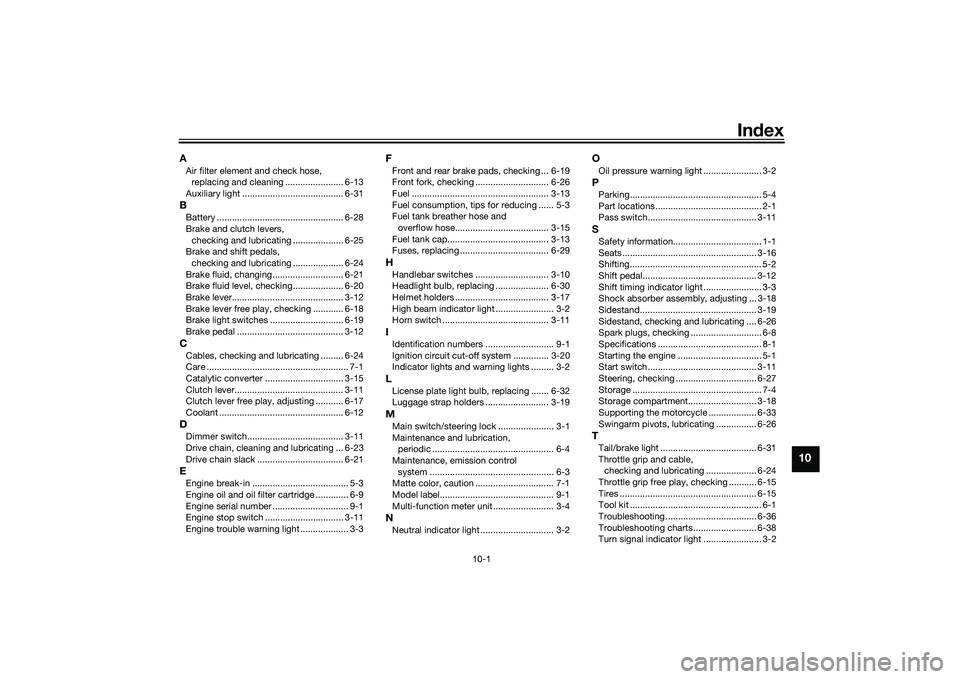
10-1
10
Index
AAir filter element and check hose,
replacing and cleaning ....................... 6-13
Auxiliary light ........................................ 6-31BBattery .................................................. 6-28
Brake and clutch levers,
checking and lubricating .................... 6-25
Brake and shift pedals,
checking and lubricating .................... 6-24
Brake fluid, changing............................ 6-21
Brake fluid level, checking.................... 6-20
Brake lever............................................ 3-12
Brake lever free play, checking ............ 6-18
Brake light switches ............................. 6-19
Brake pedal .......................................... 3-12CCables, checking and lubricating ......... 6-24
Care ........................................................ 7-1
Catalytic converter ............................... 3-15
Clutch lever........................................... 3-11
Clutch lever free play, adjusting ........... 6-17
Coolant ................................................. 6-12DDimmer switch...................................... 3-11
Drive chain, cleaning and lubricating ... 6-23
Drive chain slack .................................. 6-21EEngine break-in ...................................... 5-3
Engine oil and oil filter cartridge ............. 6-9
Engine serial number .............................. 9-1
Engine stop switch ............................... 3-11
Engine trouble warning light ................... 3-3
FFront and rear brake pads, checking ... 6-19
Front fork, checking ............................. 6-26
Fuel ...................................................... 3-13
Fuel consumption, tips for reducing ...... 5-3
Fuel tank breather hose and
overflow hose..................................... 3-15
Fuel tank cap........................................ 3-13
Fuses, replacing ................................... 6-29HHandlebar switches ............................. 3-10
Headlight bulb, replacing ..................... 6-30
Helmet holders ..................................... 3-17
High beam indicator light ....................... 3-2
Horn switch .......................................... 3-11IIdentification numbers ........................... 9-1
Ignition circuit cut-off system .............. 3-20
Indicator lights and warning lights ......... 3-2LLicense plate light bulb, replacing ....... 6-32
Luggage strap holders ......................... 3-19MMain switch/steering lock ...................... 3-1
Maintenance and lubrication,
periodic ................................................ 6-4
Maintenance, emission control
system ................................................. 6-3
Matte color, caution ............................... 7-1
Model label............................................. 9-1
Multi-function meter unit ........................ 3-4NNeutral indicator light ............................. 3-2
OOil pressure warning light ....................... 3-2PParking.................................................... 5-4
Part locations.......................................... 2-1
Pass switch........................................... 3-11SSafety information................................... 1-1
Seats ..................................................... 3-16
Shifting.................................................... 5-2
Shift pedal............................................. 3-12
Shift timing indicator light ....................... 3-3
Shock absorber assembly, adjusting ... 3-18
Sidestand.............................................. 3-19
Sidestand, checking and lubricating .... 6-26
Spark plugs, checking ............................ 6-8
Specifications ......................................... 8-1
Starting the engine ................................. 5-1
Start switch ........................................... 3-11
Steering, checking ................................ 6-27
Storage ................................................... 7-4
Storage compartment........................... 3-18
Supporting the motorcycle ................... 6-33
Swingarm pivots, lubricating ................ 6-26TTail/brake light ...................................... 6-31
Throttle grip and cable,
checking and lubricating .................... 6-24
Throttle grip free play, checking ........... 6-15
Tires ...................................................... 6-15
Tool kit .................................................... 6-1
Troubleshooting .................................... 6-36
Troubleshooting charts ......................... 6-38
Turn signal indicator light ....................... 3-2
UB04E0E0.book Page 1 Wednesday, September 2, 2015 3:51 PM